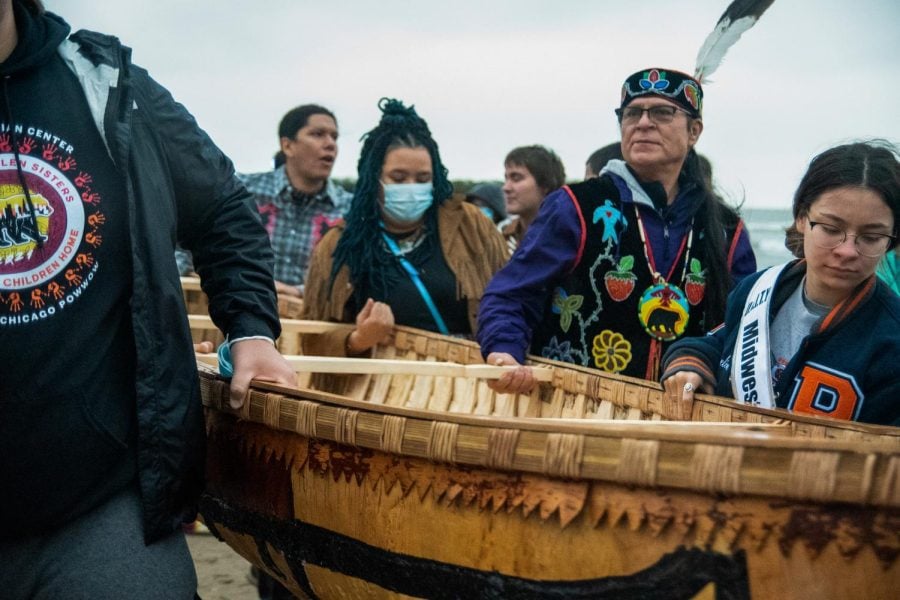NU is behind on Indigenous initiatives and enrollment, panel says
Daily file photo by Angeli Mittal
Artist Wayne Valliere (Mino-Giizhig), a Lac Du Flambeau Ojibwe, prepares to launch a birchbark canoe into Lake Michigan as part of CNAIR’s artist in residence program on Oct. 31, 2021.
January 28, 2022
While Northwestern has increased the number of Indigenous students and faculty in recent years, some community members believe the University is far behind many peer institutions.
“We are way behind in enrollment as a percentage of attendance,” said Pamela Silas, associate director of community outreach and engagement at NU’s Center for Native American and Indigenous Research, who is of the Menominee and Oneida tribes of Wisconsin. “We’re terrible. We can’t do the lofty goals we have without having more Indigenous students on campus, and the same thing with faculty.”
A Thursday panel featured NU leaders who are spearheading Indigenous initiatives on campus, highlighting major goals, issues and achievements of various Native American organizations.
Panelist Aaron Golding, assistant director of Multicultural Student Affairs and member of the Seneca Nation, said NU is a leading institution in the country by making land acknowledgements a common practice. He said the practice has become a “part of the fabric of the experience” at the University.
Land acknowledgements are now a part of Wildcat Welcome and commencement. Golding said the practice brings awareness and visibility to the Indigenous community, offers opportunities for allyship and fosters community.
With the attention and raised awareness stemming from more frequent land acknowledgements on campus came an unexpected ill effect: prejudice and bigotry, according to Golding and Silas. In November, The Rock was vandalized with anti-Indigenous hate speech.
“Land acknowledgments are something that bring a lot of attention and awareness to the community,” Golding said. “That also can bring kind of an ugly side of people.”
SESP junior Isabella Twocrow, who is Oglala Lakota and a member of the Ho-Chunk Nation, said some of the most pressing issues for Indigenous students on campus are lack of visibility and microaggressions. She said it’s hard to feel like the only Indigenous student in a class. Twocrow added that Native American initiatives are not receiving their proper recognition.
But Twocrow appreciates the University’s resources, which Silas said were not available for many older Native NU alumni.
“It feels draining at times, but I would say being here on this campus as a Native student, having these resources has been an amazing privilege and opportunity and being with (Golding) and … (Silas) and seeing their amazing work,” Twocrow said.
CNAIR’s building on campus serves as a safe meeting place and community center for the Native American community at NU, Silas said. CNAIR is also helping launch a new minor in Indigenous Studies through Weinberg College of Arts and Sciences, taking an interdisciplinary approach.
Golding said he views himself as a support system for students while they are on campus. One of the ways he performs this duty is by advising the Native American and Indigenous Students Alliance and similar student organizations.
CNAIR offers opportunities for scholarship, teaching and learning around Indigenous issues. Silas said their work is deeply influenced by dialogue with Indigenous nations and communities.
”It’s collaborative and informed by and responsive to the Native community itself, Indigenous nations and communities and we strive to foster innovation, Indigenous centered intellectual space,” Silas said. “That is open to multiple modes of engagement for faculty, students, and the community members.”
According to Silas, Indigenous students at NU participate within the larger Indigenous community in Chicago on multiple levels: volunteering, attending cultural events and engaging in community projects.
The growing number of Indigenous scholars in anthropology and political science helps add to a ripple effect of increased interest in Indigenous knowledge and scholars, Silas said. She added she is happy the circle for Indigenous initiatives is growing.
Still, Silas said they have a long way to go.
“We’re not trying to paint a picture of Utopia here,” Silas said. “We still have a lot of work to do. We really have to do a better job at creating a safe and equitable environment for these native students that come here, because they’re still shouldering way too much of the institutional change.”
Email: [email protected]
Twitter: @JackAustinNews
Related Stories:
— NAISA releases demands to Northwestern following anti-Indigenous vandalism at The Rock
— NAISA reflects on anti-Indigenous hate on campus after Rock painting vandalized
— Chicago’s Indigenous community, politicians rally for recognition of Indigenous Peoples’ Day












